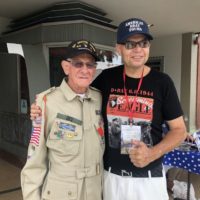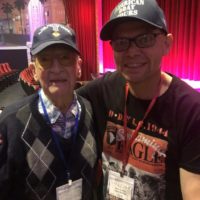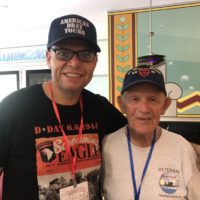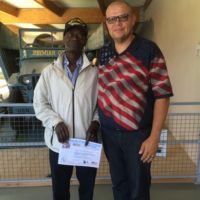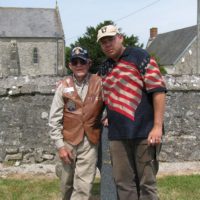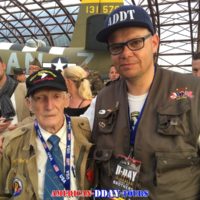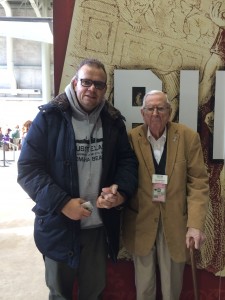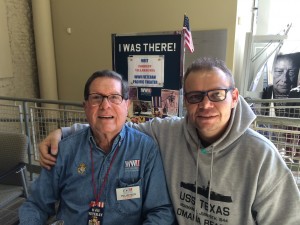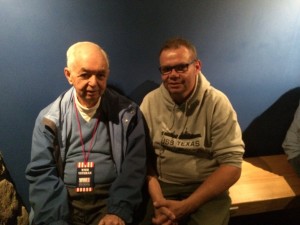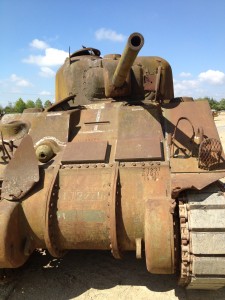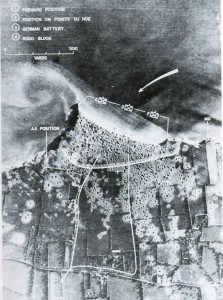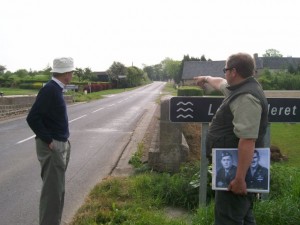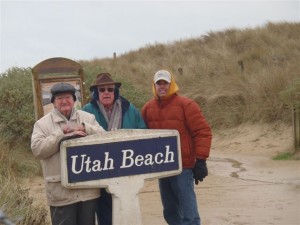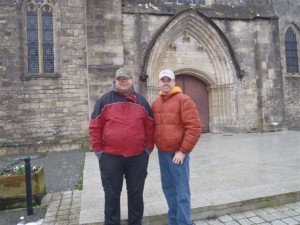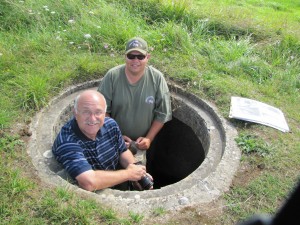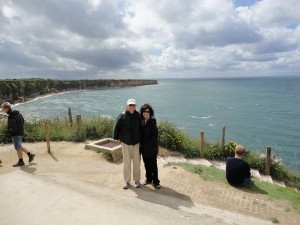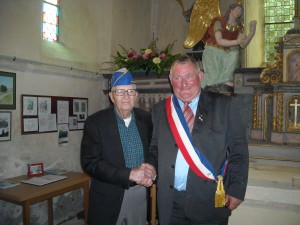D-Day and WW2 veterans and their tour of duty.
This last November I was in New Orleans for Thanksgiving week end and my wife and I went to the WW2 National Museum in New Orleans.
There I met with several WW2 veterans who where very kind and didn’t mind sharing stories of what they did, where they fought and their war experiences but also interacting with the locals.
If you are in New Orleans I REALLY recommend you visit this museum, it is astounding ! and because we were short time wise, we only did the European Theater of Operations, but should have visited the Pacific Theater. I’ll have something to look forward doing later. This is a museum where you can actually meet the men who were there, and believe me at a rate of a 1000 per day, pretty soon there won’t be many WW2 veterans left.
Please , if you ever meet one, shake his hand, hug him gently and thank him for his service.
Tom Blakey was a paratrooper (19 years old) and fought in Normandy from 6th on to Holland to the end of the war. He told me he discovered “Cider, Calvados and Krauts”, Tom will be coming over to Normandy in June, I hope I get to see him again.
Forrest Villarubia was in another part of the globe but fighting was just as intense, he was in the Pacific Theater and was particularly in Leyte, Philippines. Having a good sense of humour I told he I was glad to have met him and he said he was glad to have met my wife.
While I was visiting the exibits I had a moving experience as my wife and I spoke with a WW2 veteran his name :
Rosen Elseworth he was a Staff Sgt from the 36th Division also known as the Texas Division.
He was a bearing witness to the liberation and release of people interned at Dachau. We both had tears rolling down our eyes as he explained to me of his arrival at the concentration camp in Dachau.
He came to France for the 50th anniversary of D-Day in 1994 and was well taken care of by French people who were happy to have a veteran with them for a couple of days. This charming elderly man even managed to speak some French to my wife.
He landed at Omaha Beach in October of 1944 and probably made his way off the beach through the E – 1 exit or E- 3 exit.
We were very pleased to be able to meet a wonderful man. I thanked him earnest and said. ” Thank You Sir for my freedom, I’ll never forget”.
D-day didn’t just bring troops over here …a lot of stuff was left behind, but plaques and monuments are still here as a reminder…
Sure it’s been 69 years since our troops ran across those beaches, and dropped out of C-47’s in order to bring mayhem to the German occupying forces along the Normandy coast and further inland. American engineers cleaned up a lot of stuff that was left on the beaches here by the Germans such as beach obstacles, barbed-wire and all the blown up guns, but the mines too, un-exploded ordonnances maybe even some dud arial bombs that didn’t detonate once released from the air.
American engineers not only cleared the beach exits so troops could get off the beach, but set up fuel dumps, machine gun emplacements as well as anti-aircraft ground fire (even though the Luftwaffe never really posed a threat) but mainly they are builders build new and wider road sometimes even creating roads where there weren’t any, re-building the port of Cherbourg building ALG’s (advance landing ground = airfield) and as the Normandy campaign came to an end then moved on…
A lot of the stuff was re-used by the local population who had been deprived of quite a few ressources during the German/Nazi occupation of Normandy, these people are going to make used of anything and everything they can get they’re hands on.
Whether it be German equipment or American equipment (often US Army supplies) if it could be used for something it would.
Today if you know where to look you can still see left-overs of the war, many farmers here in Normandy use PSP (pierced steal plating) as a fence or part of a fench, it’s the same PSP that was used for the airfields and runways that were laid out on the ground where U.S. Aircorp would bring in planes.
Relics of all shapes and sizes can be found in private collections or museums. Plaques little know by the general public can often be found when you’re not looking for them and just happen to stumble upon them around a corner on the edge of a house.
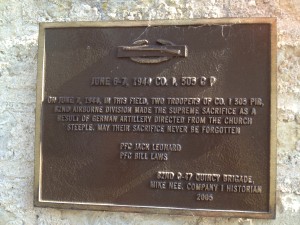 A rusted sherman tank is still an impression piece of machinery.
A rusted sherman tank is still an impression piece of machinery.
D-DAY FULL EXPERIENCE TOUR PACKAGE (2 DAY TOUR)
Pickup in Bayeux or Carentan at your hotel or train station
You’re really interested in the events leading up to D-Day, but also all the little side stories that made this big endevour not just a main strategy but also a soldier’s war with many personal stories of men who fought for freedom, democracy and the hope that the Nazi regime would be ended. My 2 day tour allows you to go to the different sites without having that rushed feeling like you might have on a one-day tour when we try to see as many sites as possible !
With the 2 day tour, go at your own pace, with me as your guide, we will explore some non-visited sites by other tour companies and find out the stories behind this house, this river, this tree or this cross-road…
All inclusive means you don’t have to be worried about lunch, I will take you to eat at places where I eat when not guiding, we will enter the museums and not wait in line so we can maximise our time.
Tour starts at around 8.30 – 9.00 am and finished around 5.30 – 6.00 pm
Day 1 Airborne Sector & Utah Beach
La Fière (Merderet River)
PFC Charles Deglopper 325th GIR (MOH)
Sainte Mère Eglise (story of the battle for the town)
Utah Beach Memorial Museum or Sainte mère Eglise Airborne Museum
LUNCH
WN 5 Utah Beach
Angoville-au-Plain (2 medics in a church)
Graignes (AKA the “Alamo of Normandy”)
Day 2 Rangers area & Omaha Beach
La Cambe German Cemetery
Pointe-du-Hoc
LUNCH
Omaha Beach (seen from 3 to 4 different angles)
Omaha Beach Memorial Museum
American Military Cemetery
(+ visitor’s center if we have time)
Pick-up & Drop-off FREE for Bayeux (if further fee may apply)
Full D-Day Experience Tour Package2 Days all inclusive :– pick up & drop off– museums and meals included
|
1 to 4 people€ 1200
|
5 to 6 people€ 1400 |
7 to 8 people€ 1600 |
Pictures of former guests with American D-Day Tours
Just send me your pictures of you here in Normandy in front of some place that we visited that has importance to you or with you and me on same picture and I’ll post it here…
[one_half] [/one_half] [one_half_last] [/one_half_last] [one_half] [/one_half] [one_half_last] [/one_half_last] [one_half] [/one_half] [one_half_last] [/one_half_last] [one_half] [/one_half]D-day Normandy landings and Battle of Normandy campaign veteran…
Greetings everyone,
I had the honor and privilege of meeting Don Casey recently and we finished the day by going to the American Military cemetery in Colleville-sur-Mer where he paid his respects to 7 soldiers, 3 of them were men he knew, it was a very moving experience and very emotional too as it was his first time back in 68 years…
Donald (Don) Casey was born in 1923 in North Carolina. He joined the army in 1942. He traveled briefly to North Africa specifically Morrocco with the 238th and then went to England.
He landed at 8.30 am on Utah Beach
After the D-Day landings the 238th went through France, Belgium and Germany. Mr. Casey was injuried in Belgium in January of 1945 and was evactuated to England. He received the Purple Heart and was discharged later 1945. The 238th laid 66 bridges in Europe including the first one built in Normandy just off of causeway number 2 near Utah Beach.
Below is a link to the group’s home page which has good map of where the 238th went in Europe.
http://238thengineercombatbtn.com/Home_Page.php

Normandy Campaign D-day Veteran Feb. 2012
Jay landed here…68 years ago
On Wednesday February 1st 2012 I had the privilege and honor of meeting Forest « Jay » Nichols, he prefers we him call him « Jay ».
His visit to Normandy, with his wife, Becky, son, Steven, and daughter in-law, Becky, coincided with the Airborne Museum re-opening its doors for the 2012 season.
Private Nichols’ story in Normandy began almost 68 years ago, at 1.30 am on the early morning of June 6th 1944 (He was in Baker Company 502nd of the 101st Airborne). He landed near Turqueville.
Jay’s story, in his own words:
Around 1.30 in the morning our jump light, which was red ( the signal for the paratroopers to « hook-up ») turned green and the signal was given to jump. I didn’t feel like staying around because of the sound of flak exploding all around us and bullets zipping past us.
Out of my stick ( usually 18 paratroopers) only 3 of us managed to re-group together, my two buddies who had jumped right behind me as I went out of the plane, but I didn’t find them right away.
As soon as I hit the ground I hurried to get out of my parachute. When I checked for my gear after inspecting my carbine I realized that the impact upon hitting the ground had been so violent that I had snapped the folding mechanism and the stock so the rifle was useless.
I could hear some weird sounds
I could hear some weird sounds. After a moment that I realized I had landed in a field full of sheep! Not wanting to attract any unwanted attention I crawled at the height of the sheep and followed their movement so I could get across the field.
In the night crouching down in a ditch just behind a hedgerow I could hear voices approaching. I remembered to pull out my clicker ( a device given to us just before leaving England; we were told to produce one click and to respond by making two clicks ) and did one click. Now the sounds were turning into chatting, and not wanting to get shot when I finally distinguished after straining hard to listen that is was English that was being spoken. I made my presence clear by shouting « Hey I’m over here »
Boy was I happy to recognize those two voices!
…the enemy and they were all around us
After linking up with my two friends, and asking them if they had seen anyone else from our stick, we decided to make our way towards Sainte Mère Eglise. We proceeded to climb through the thick hedgerows — and believe me those things aren’t easy to get through — cutting up our hands and ripping our uniforms. We didn’t want to reveal our presence to the enemy and they were all around us.
Some of my buddie got killed, wounded and captured, becoming POW’s, that night.
We fought the Germans for several hours that night. We’d toss our grenades over the hedgerows at them and they would throw theirs. They had a grenade with a handle on it that we called a masher it made more bang than harm. When we finally made our way into Sainte mere Eglise with one wounded in tow, day light was breaking .Upon arrival in Ste Mere Eglise, sniper fire coming from the church made me crouch behind a stone with bullets ricocheting just above my helmet.
Having being miss-drop and scattered we were finally re-attached to the 505th of the 82nd Airborne ( the guys who took and secured the town that night).
My friends and I hung around Sainte Mere Eglise until June 11th when I saw a truck from the War graves Commission filled with bodies. I knew they were paratroopers; you could tell by the way the bodies had been put in the back. Their heads towards the front and their feet sticking out the back, bodies were stacked three men high.
I told my buddies “hey lets hop on it and see where it takes us.” When it finally stopped we were on Utah Beach. Then we got back on an ammunitions truck and made our way to Sainte Come du Mont, where we re-grouped with what was left of our battalion. Then we headed toward Carentan and proceeded to take the town from the German opposition.
( Carentan was completely liberated on June 12th.. It was vital to the Allied forces that Carentan was in American hands as this is the town where troops coming off of Utah Beach and Omaha Beach would link up to push south toward St. Lo )
“that’s pretty much it,son.”
We were told we’d be in Normandy for three days. We ended up staying for a little over a month. Then I boarded an LST back to England and later in September on the 17th I parachuted again into Holland for Operation Market Garden.
Jay fell silent. He was teary-eyed — who wouldn’t be? — he looked up and said “that’s pretty much it,son.”
He told me « We were told there’d be some pretty French woman here in Normandy, but I never saw any civilians »
“Maybe they we being held in the cellars so as to not fall under the charm of these paratroopers.”
Jay, who is 91, said this would be his last visit to Normandy because “my voice is slow, my legs are weak, I’m worn out.”
I had a really great time in his presence and when I’ll be touring going through the Normandy countryside I’ll stop and tell people about the hedgerow and the fighting that went on around here 68 years ago, I will tell them about (Pvt.) Jay Nichols. He personifies what he and others did for us (so we didn’t have to) and they will never be forgotten … never.
T.STANDEFER
D-day monuments that are rarely heard about…
Everyone knows about the famous monuments that pay tribute to our soldiers at the different places that are high-lighted on the tours given here in Normandy, but there are quite a lot of other monuments and places, that give thanks to US and other allied soldiers that gave their lives for our freedom. No one knows about them. That’s why I think it’s important that people who are interested in the Normandy campaign, but also all of WW2’s European theater of Operations should come to this post and check out what’s new. I’ll try to update every other week with stuff related or about the Landing Beaches and what happened on June 6th and after…
Trevières is a small village located south of the RN13 about 3 to 4 miles inland from Omaha Beach. The 2nd Inf. Div once getting off Omaha beach probably going thru the D-3 exit found themselves going inland the objective : St. LO, by June 10th Trevière had been liberated by American Forces. After a two day assault on the town the Germans backed out, and the people living there were free of mouvment and the 4 year occupation of their town by German forces had ended.
WW1 had taken it’s toll on the French and many small villages have monument dedicated to WW1 in Trevières they have their monument for the “great war” as it was known, well enemy shells started raining down on the town as American advanced further inland and a shell burst hit their WW1 monument, the townsfolk decided that they would leave the statue in it’s original state so that people would remember the horrible fighting that happened in and around that area.
The pictures show the damaged monument(below) and the 2nd Infantry’s monument (above) as well.
Normandy WW2 veterans and Trevor Standefer
Years are going by and these men aren’t immortal but my encounter with them and the stories they’ve told me has enriched me greatly…
If you ever get the chance to meet a WW2 vet never forget to thank them for what they did. Ask plenty of questions let them tell you their stories they have amazing tales…


